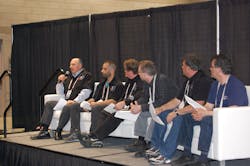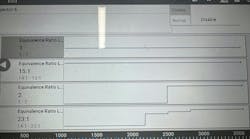PTEN magazine held a pair of Tool & Equipment Roundtables at Automechanika Chicago. Expert panels made up of automotive aftermarket shop owners, technicians and educators took some time to discuss the tools, equipment, technology and trends that allow shops to run at peak performance.
Below are some of the questions that came up during the roundtables, and the corresponding answers that were provided by the experts.
Q: What is the most critical tool or piece of equipment used in your shop?
G. Jerry Truglia, president, Automotive Technician Training Services (ATTS) and Technicians Service Training (TST), Mahopac, N.Y. – I would say that it is a scan tool. That is one the most important things besides an information system.
Jeff Minter, education director for transportation and marketing, Wisconsin Technical College System – I’d agree the scan tool is at the top of the list, but it is also one of the biggest challenges. The variety of scan tools and the limitations and issues we find in the aftermarket tools have to be dealt with.
Ed Hazzard, owner, Automotive Tech Systems, Newburgh, N.Y. – I’m going to go outside the box. The most critical tool I think is your mind. Knowing what you are working on is so important. As far as the most critical piece of equipment, though, I’d say it’s the scan tool or the information system.
Q: What tool trends have you seen in the past five years that have changed your business?
Josh Mahtaban, technician, PSEG, Clifton, N.J. – It’s kind of hard to do anything without a factory (scan) tool, to a certain (extent).
Minter – The scan tool move toward a common interface platform that we’re seeing is still transitioning, but it’s definitely headed in the right direction. It’s much better than what we’ve seen in the past five to 10 years, where it was almost impossible for a shop to own a significant number of OE tools because of the cost. Also, the training that is available to techs, both remotely and live, has changed greatly. It really improves their ability to use those tools.
Vincent LaDuca, LaDuca Auto Service, Pleasantville, N.Y. – Information has made huge leaps and bounds in the last five years. The better information has really helped us to fix cars more effectively.
What tool trends do you see coming in the next five years that will change your business?
Truglia – I think you are going to see more downloadable tools. They will be a little more intuitive, and it will be easier to find the information you need quicker and faster. Some of the scan tools that are actually out there were put together by software engineers, and it’s not as (good) as if a technician was involved in building that tool. I think there will be more feedback (from technicians) in the future.
Hazzard – It seems like more and more manufacturers are going to be using the J2534 (vehicle communication) interface in the next few years.
Minter – Some of the OEMs are already integrating their service information system, their electrical diagrams and their scan tool all together to kind of make a seamless path for the technicians to follow during their diagnostics. Rather than having to use the tool and go to a database and a manual to go look up something, it’s really an interactive experience. As we start to move into the next generation of communication capabilities, I think that’s just going to continue to grow over the next 5-10 years.
Q: When you are thinking about purchasing a new tool, how far in the future do you look?
Eric Dibner, Euro Auto, Bethlehem, Conn. – I always ask myself what it’s going to cost me if I don’t get that piece of equipment. It could cost you a lot of money. But it now and look into the future to see what’s going to help you not make a mistake.
LaDuca – I look at what I expect my return on investment to be. If I see a need for a particular tool or technology, and that need has come up three or four times, at that point I start researching and eventually buying the tool.
Q: How do new tools and technologies help to make your shop a connected shop? Does a connected shop mean a more profitable shop?
Dibner – My best tool is my smartphone. I can show customers how I repair their cars, step by step. This tool does so much for your business.
LaDuca – It is very important to be considered a connected shop. What that means to me is showing your customer, through technology, that they can feel confident that you can work on their (car). It definitely pays to have the technology and being able to communicate with your customers, even by just sending them an email with a photo, or texting them a photo. It goes a long way.
Hazzard – As a mobile tech, a new technology I’m looking at is if you are programming a car at a shop, and another shop calls and says “I’m having a problem with this,” you can log on to (the other shop’s computer) and diagnose something while you are working on your computer. It’s multitasking, and it’s those kind of remote diagnostics that I think will be a new technological trend.
Q: Given all the recent talk about telematics, do you feel there is a market for that at this point? And when it comes to your shop’s capabilities, what would you need to have to utilize something like that in a good way?
Truglia – I think there is a market, and it’s a good way to retain customers. But you need to have the right equipment. Either give it to the customer, sell it to the customer, mark it up, or whatever. But now you are selling them a service if there is a problem. My only concern is if you leave something in the diagnostic port for too long, what liability may you have down the road if it’s interfering with something? But if you tell the customer that if they see something funny, they can plug it in and then you can see the information on the other side. Remote diagnostics is going to be big, big money down the road.
LaDuca – People that take care of their vehicles want peace of mind. Having a connection to your shop that can detect something the minute it goes wrong in the car will sell itself.
Minter – One thing to consider now in terms of customer expectations is immediate service and connectivity. They expect it if there computer breaks. As we see the OEMs have this capability, it’s expected if the aftermarket can’t do it, then there is a hole that the aftermarket has that the OEMs can take an advantage of and provide.


